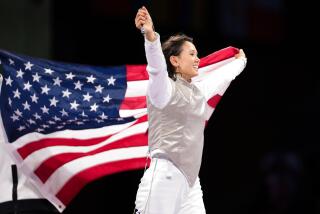Fencers Compete to Decide Who Is a Cut Above the Rest
- Share via
Michael Bradley faced swift elimination, but the chance to cross sabers with world-class fencers outweighed the prospect of humiliation.
“This is my first competition in 12 years,” said Bradley, 30, of Ojai. “These guys are all rated fencers. They had me on speed.”
Two Ventura County Fairgrounds pavilions became a gallery for the art of the duel over the weekend, when 500 American and international fencers competed in one of the United States Fencing Assn.’s four biggest tournaments of the year.
On 2-by-14-meter wooden boards, the contestants lunged and parried their way through the double-elimination tournament, amassing points to qualify for the 1991 World Championships and Pan American Games.
Bradley, who heads the Pierpont Fencing Club in Ventura and competed years ago as a University of New Hampshire freshman, was eliminated in the first round of the saber category. Sergei Mindirgasov of the Soviet Union, a 1990 world champion, won the event.
Despite electronic sensors used to detect scoring touches, the sport remains largely unchanged from medieval times, when swordsmen avenged an insult or a woman’s honor and victory generally went to the combatant who drew first blood.
Among the ranks of fencers at Sunday’s finals were lawyers, military officers, sales representatives and medical students. All but the top few, whose expenses are subsidized by the national association, paid their own way.
Most competitors in the three men’s and two women’s categories were over 30 and took up the sport in college, said Candi MacConaugha, a tournament organizer. Older fencers can still excel, she said, because subtle thumb movement is more important than endurance in the five- and six-minute bouts won with five “touches.”
“This is a game of cunning more than strength, but you must practice constantly because it requires unnatural movements,” said MacConaugha, 46, who took up the sport four years ago.”This is a sport where age and cunning will beat youth and agility.”
The three categories in the tournament were epee, in which points are scored with the tip of the blade anywhere on the body; foil, in which contact is limited to the torso; and saber, in which points are scored with either the length or the tip of the blade.
Ann Marsh, who placed third Sunday in women’s foil, said she began fencing at age 12 out of dissatisfaction with team sports at her private school in Michigan.
“I didn’t like volleyball because people didn’t take it seriously, and I didn’t want to practice if all everyone worried about was breaking their nails,” said Marsh, a 19-year-old freshman at Columbia University in New York.
Mark Niemiec, 27, of Boulder, Colo., said he became a fencer in high school because it required more brains than brawn. “It’s the kind of sport, if I can say it, that all the nerds fell into, sort of like the chess club,” said Niemiec, who finished among the top 24 in the epee category.
Ojai’s Bradley admitted his was a more common inspiration. “Errol Flynn in ‘Captain Blood.’ I was hooked at age 8.”
More to Read
Go beyond the scoreboard
Get the latest on L.A.'s teams in the daily Sports Report newsletter.
You may occasionally receive promotional content from the Los Angeles Times.







